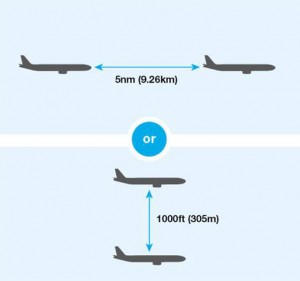Separation standards refer to the minimum distance apart that aircraft operating in controlled airspace and at airports with an operational control tower must be kept. These are outlined in the Manual of Standards for Air Traffic Services and our air traffic controllers use them to safely manage air traffic.
Different separation standards apply to aircraft operating under instrument flight rules (IFR – all large passenger aircraft) or visual flight rules (VFR - most light aircraft and helicopters). Air traffic controllers must keep aircraft separated vertically or horizontally.
How close can they go—IFR aircraft
In Australia, aircraft flying under instrument flight rules (IFR) in controlled airspace up to 29 000 ft (8800 m) must be separated by 1000 ft (305 m) vertically unless they are separated horizontally.

Above 29 000 ft, the vertical separation increases to 2000 ft (610 m), except in airspace where Reduced Vertical Separation Minima (RVSM) is applied.
When aircraft are separated vertically, horizontal separation can be reduced without compromising safety.
In controlled en route airspace, the horizontal separation standard between aircraft flying at the same altitude is 5 nm (9260 m). In terminal area airspace, the minimum separation is 3 nm (5500 m). Within the confines of an airport control zone, the separation can be as close as practicable as long as the aircraft remain separated.
In airspace not monitored by radar or other satellite-based navigation services, aircraft separation is achieved by the use of various procedural rules including time and estimated position.
How close can they go—VFR aircraft
In the air, separation of aircraft operating under visual flight rules (VFR) depends on where aircraft are flying. In the vicinity of capital city airports (controlled airspace), VFR and IFR aircraft are separated by similar horizontal standards as between two IFR aircraft, however, IFR and VFR flights may be separated vertically by a reduced standard of 500 ft (152 m) under certain circumstances.
Outside controlled airspace, VFR aircraft operate under ‘alerted see and avoid’ principles, whereby pilots rely on a mix of visual scanning, radio broadcasts, air traffic control flight information and various ‘give way’ rules of the air to remain clear of other aircraft and avoid risk of collision.